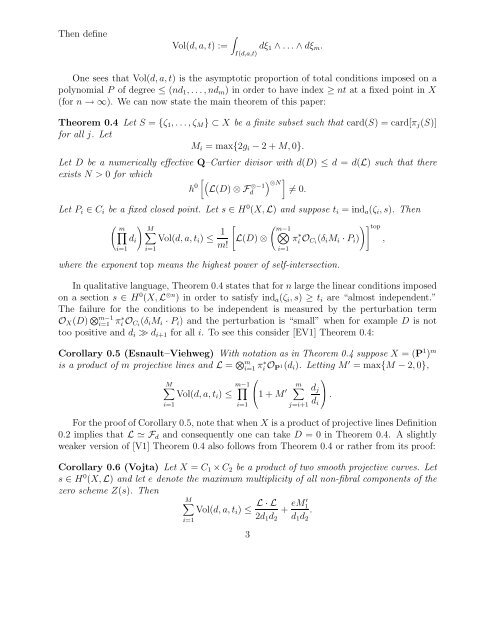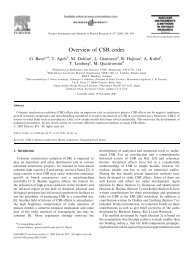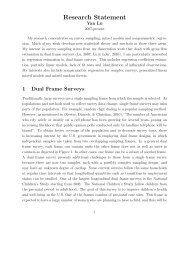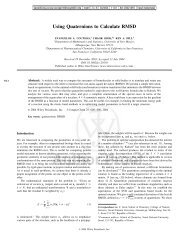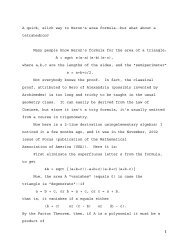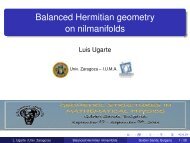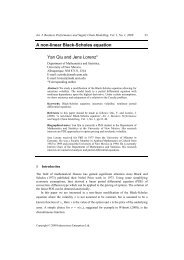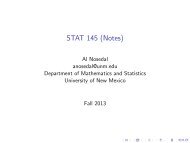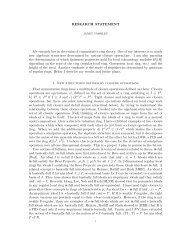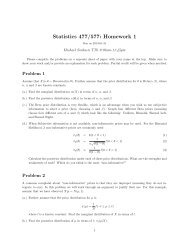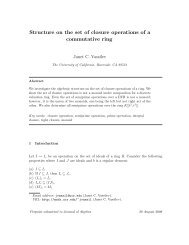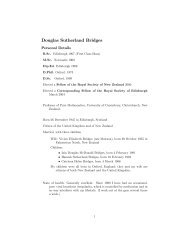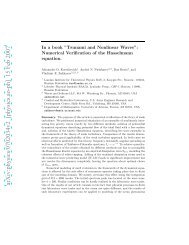Dyson's Lemma and a Theorem of Esnault and Viehweg
Dyson's Lemma and a Theorem of Esnault and Viehweg
Dyson's Lemma and a Theorem of Esnault and Viehweg
You also want an ePaper? Increase the reach of your titles
YUMPU automatically turns print PDFs into web optimized ePapers that Google loves.
Then define∫Vol(d, a, t) :=I(d,a,t)dξ 1 ∧ . . . ∧ dξ m .One sees that Vol(d, a, t) is the asymptotic proportion <strong>of</strong> total conditions imposed on apolynomial P <strong>of</strong> degree ≤ (nd 1 , . . .,nd m ) in order to have index ≥ nt at a fixed point in X(for n → ∞). We can now state the main theorem <strong>of</strong> this paper:<strong>Theorem</strong> 0.4 Let S = {ζ 1 , . . .,ζ M } ⊂ X be a finite subset such that card(S) = card[π j (S)]for all j. LetM i = max{2g i − 2 + M, 0}.Let D be a numerically effective Q–Cartier divisor with d(D) ≤ d = d(L) such that thereexists N > 0 for which [ (L(D) ) ]h 0 ⊗ F⊗−1 ⊗Nd ≠ 0.Let P i ∈ C i be a fixed closed point. Let s ∈ H 0 (X, L) <strong>and</strong> suppose t i = ind a (ζ i , s). Then(∏ m)∑ Md i Vol(d, a, t i ) ≤ 1 [L(D) ⊗i=1 i=1m!( m−1 ⊗i=1π ∗ i O Ci (δ i M i · P i ))] top,where the exponent top means the highest power <strong>of</strong> self-intersection.In qualitative language, <strong>Theorem</strong> 0.4 states that for n large the linear conditions imposedon a section s ∈ H 0 (X, L ⊗n ) in order to satisfy ind a (ζ i , s) ≥ t i are “almost independent.”The failure for the conditions to be independent is measured by the perturbation termO X (D) ⊗ m−1i=1 πi ∗ O Ci (δ i M i · P i ) <strong>and</strong> the perturbation is “small” when for example D is nottoo positive <strong>and</strong> d i ≫ d i+1 for all i. To see this consider [EV1] <strong>Theorem</strong> 0.4:Corollary 0.5 (<strong>Esnault</strong>–<strong>Viehweg</strong>) With notation as in <strong>Theorem</strong> 0.4 suppose X = (P 1 ) mis a product <strong>of</strong> m projective lines <strong>and</strong> L = ⊗ mi=1 π ∗ i O P 1(d i). Letting M ′ = max{M − 2, 0},⎛M∑m−1 ∏Vol(d, a, t i ) ≤i=1i=1⎝1 + M ′m ∑j=i+1⎞d j⎠.d iFor the pro<strong>of</strong> <strong>of</strong> Corollary 0.5, note that when X is a product <strong>of</strong> projective lines Definition0.2 implies that L ≃ F d <strong>and</strong> consequently one can take D = 0 in <strong>Theorem</strong> 0.4. A slightlyweaker version <strong>of</strong> [V1] <strong>Theorem</strong> 0.4 also follows from <strong>Theorem</strong> 0.4 or rather from its pro<strong>of</strong>:Corollary 0.6 (Vojta) Let X = C 1 ×C 2 be a product <strong>of</strong> two smooth projective curves. Lets ∈ H 0 (X, L) <strong>and</strong> let e denote the maximum multiplicity <strong>of</strong> all non-fibral components <strong>of</strong> thezero scheme Z(s). ThenM∑Vol(d, a, t i ) ≤ L · L + eM 1′ .2d 1 d 2 d 1 d 2i=13


